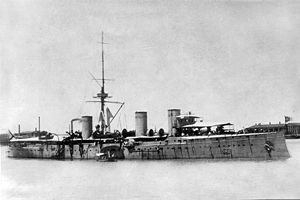Russian cruiser Zhemchug

Russian cruiser Zhemchug
|
|
| History | |
|---|---|
|
|
|
| Name: | Zhemchug |
| Builder: | Nevsky Shipyards, St Petersburg, Russia |
| Laid down: | 19 January 1901 |
| Launched: | 14 August 1903 |
| Commissioned: | 26 July 1904 |
| Fate: | Sunk in the Battle of Penang on 28 October 1914 |
| General characteristics | |
| Class and type: | Izumrud-class protected cruiser |
| Displacement: | 3,103 long tons (3,153 t) |
| Length: |
|
| Beam: | 12.20 m (40.0 ft) |
| Draught: | 4.90 m (16.1 ft) |
| Installed power: | 17,000 hp (13,000 kW) |
| Propulsion: |
|
| Speed: | 24.5 knots (45.4 km/h; 28.2 mph) |
| Range: | 2,090 nautical miles (3,870 km; 2,410 mi) at 12 knots (22 km/h; 14 mph) |
| Complement: | 354 officers and crewmen |
| Armament: |
|
| Armour: |
|
Zhemchug (Russian: Жемчуг, "Pearl") was the second of the two-vessel Izumrud class of protected cruisers built for the Imperial Russian Navy. She was sunk during World War I by the German light cruiser Emden in the Battle of Penang.
Zhemchug was ordered as part of the Imperial Russian Navy’s plan to expand the Russian Pacific Fleet based at Port Arthur and Vladivostok to counter the growing threat posed by the Imperial Japanese Navy towards Russian hegemony in Manchuria and Korea.
Zhemchug was laid down at the Nevsky Shipyards in Petrograd, Russia in January 1901. However, construction was delayed due to priority given to completion of the Russian cruiser Novik. The Zakladka, or formal ceremony of laying a plate, took place on 14 June 1902, in the presence of Grand Duke Alexei Alexandrovich.
She was launched on 14 August 1903, in the presence of Tsar Nicholas II and Dowager Empress Maria Feodorovna. Construction continued to be plagued by delays, including flooding in November, and an ice storm in December. However, with the start of the Russo-Japanese War in early 1904, construction efforts were greatly accelerated. Mooring tests were completed by 26 July 1904 and speed trials were held on 5 August. Zhemchug was formally commissioned on 29 August 1904 and was assigned to the Second Pacific Squadron of the Russian Pacific Fleet. On 27 September 1904, she participated in a naval review off Reval attended by Tsar Nicholas II, and departed for the Far East the following day.
...
Wikipedia
